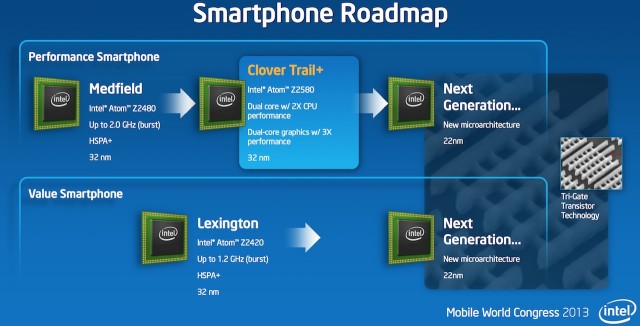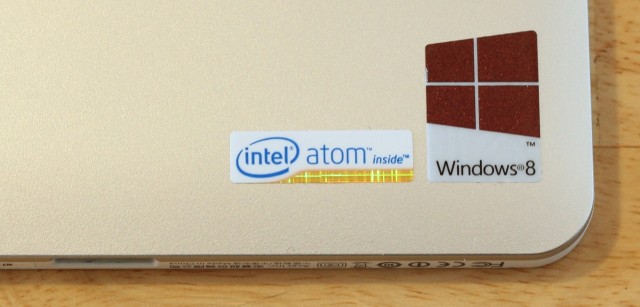
Clover Trail+ is the next stop on Intel's smartphone roadmap.
The CPUs were designed from the outset to prioritize power usage over performance—a design philosophy that defines the ARM-based chips in most of today's smartphones and tablets—but the first Atom processors in netbooks were paired with old, relatively power-hungry chipsets that negated their power-saving prowess. The chipsets eventually became more efficient (and, in some cases, were integrated into the same silicon as the CPU itself), but today's Atoms remain stuck with lackluster GPUs that seriously hamper their usefulness for the visually slick Windows 8 (just see our benchmarks of Acer's Iconia W510 to see proof positive of all three of those observations).Intel's Atom processors have evolved in many ways in the five-or-so years since their introduction, but it seems like they've never quite been an ideal solution for any given application.
2013 may be the year where all of that changes. We've known bits and pieces of Intel's Atom roadmap for a while now, but the company is talking more freely about its future plans at Mobile World Congress this week. You probably won't see any sort of Intel-driven sea change in phones and tablets this year—new chips from Qualcomm, Nvidia, and Samsung are more than competitive enough to keep that from happening—but some of these new Atoms may just be products that can be recommended without serious reservations.
Clover Trail+

A (simplified) diagram of all of Clover Trail+'s ingredients.
If you occasionally have trouble keeping Intel's product code names straight, this one should be easy to figure out: it's similar to the Clover Trail platform currently shipping in Atom-based Windows 8 tablets, with a few notable tweaks.
Like Clover Trail, Clover Trail+ is a dual-core CPU with Hyperthreading that's built on the same 32nm process as Intel's Sandy Bridge processors. The main differentiating factor is the system-on-a-chip's GPU, which has been upgraded from a single-core Imagination Technologies PowerVR SGX 545 to a dual-core PowerVR SGX 544MP2—this GPU is essentially the same one as the PowerVR SGX 543MP2 used in Apple's A5 processor, but it adds Direct3D 9 support (for the benefit of Windows, one assumes). Intel's implementation of the GPU also runs at higher clock speeds than the reported 250MHz of the A5—300, 400, or 533MHz, depending on whether your CPU is the 1.2GHz Z2520, 1.6GHz Z2560, or 2.0GHz Z2580.
The upshot is that Clover Trail+ should have much better graphics performance than Clover Trail mark one, which didn't impress us much when we reviewed Acer's Iconia W510 tablet. The GPUs in chips like Apple's A6X, Samsung's Exynos 5 Dual (and Octa), Nvidia's Tegra 4, and Qualcomm's Snapdragon 600 and 800 chips are all going to offer more impressive performance, but Clover Trail+ should at the very least have no issues running at its maximum supported resolution of 1920x1200.
Clover Trail+ is intended for use in both tablets and smartphones, replacing Clover Trail and the single-core Medfield respectively. Intel told Ars that Clover Trail+ should be "in the same power envelope" as Medfield despite its extra CPU core, faster GPU, and identical manufacturing process. Intel's power gating features (whereby parts of the SoC can be entirely turned off when not in use) will probably ensure similar battery life to Medfield in most light-to-medium workloads, though anyone who is really pushing the hardware will probably still see an increase in power usage.
Moving on from the CPU and GPU announcements, Clover Trail+ can also be paired with a slightly updated Intel modem—the Intel XMM 6360 supports faster HSPA+ data speeds than the older XMM 6260 (42Mbps and 11.5Mbps compared to 21Mbps and 5.7Mbps), but it still lacks LTE—Intel told us that its multimode LTE modem will begin shipping "in the first half of this year." We suspect that a lack of LTE support may be one of the factors keeping Intel's chips out of US phones, so this is definitely something to look forward to.
Finally, Clover Trail+ will feature support for Android in both phones and tablets—the original Clover Trail was notably a no-Linux zone. Clover Trail+ will come to market first in Lenovo's IdeaPhone K900 smartphone, which was shown off at CES last month, and it will also reportedly power a rumored 7" tablet from Asus called the Fonepad, so named because it supports voice calls as well as cellular data.
The good stuff: Atom, redesigned

So far, these leaked slides of the Bay Trail platform's "Valleyview" SoC have proven remarkably prescient.
Clover Trail+ is a nice bump to the original Clover Trail SoC, but it's not the generational bump that we're looking for. For that, we'll have to wait for Merrifield (Smartphones) and Bay Trail (tablets), the latter of which should be available in shipping products this holiday season.
We don't know as many specifics about either of these SoCs yet (Merrifield in particular is merely listed as "forthcoming," though our sources told us the chips should show up later this year), but we do know that Intel will be making them using the same 22nm manufacturing process as its current Ivy Bridge CPUs—this will allow larger performance increases without also increasing the power usage compared to their predecessors.
These new Atoms will also feature the new "Silvermont" Atom architecture, which represents the first major redesign that Atom has had since its introduction—most notably, the Silvermont CPUs will use an out-of-order (OoO) architecture that should provide a nice boost to the chips' performance-per-clock. An OoO architecture would have consumed too much power relative to its performance benefit back when Atom was originally introduced, but the 22nm process should offset any increases in power consumption relative to current Medfield and Clover Trail SoCs. Bay Trail also boosts the core count to increase multithreaded performance, going from two cores to four.
Intel wouldn't confirm this for us when we spoke with them, but if rumors are true then Bay Trail (at least) should also be the first Atom SoC to switch from a licensed Imagination Technologies GPU back to one of Intel's own designs. This GPU is said to be architecturally identical to the integrated graphics currently used in Intel's Ivy Bridge CPUs, but with fewer of Intel's "execution units"—four, compared to the 16 in the HD Graphics 4000 and six in the lower-end HD Graphics 2500. Though its performance will be lower than in Ivy Bridge, it will support all of the same APIs (including Direct3D 11, OpenGL 4.0, and OpenCL 1.1), and as we pointed out in our W510 review, even a quarter of HD 4000's performance is still substantially quicker than the GPU in Clover Trail (though it's harder to say how it will stack up against Clover Trail+).
Better Atoms all around, but there’s an uphill fight ahead

The atom is seeing some success in tablets, but its ARM-based competitors are many.
With these new chips (especially Bay Trail and Merrifield) and an LTE baseband, Intel should finally be poised to push beyond its current "good enough" emerging-markets smartphones and make a play for the phones we pay a bit more attention to around these parts—mid-to-high-end handsets with corresponding mid-to-high-end performance.
In tablets, the company has a fighting chance—Windows gives x86 chips a rallying point in tablets and convertibles that they don't really have in the more ARM-centric smartphone market. The Clover Trail+ and Bay Trail platforms will both support Windows 8 and Android, opening the door to hybrid devices that (given a good design) could fulfill Microsoft's one-device-fits-all promise much better than Windows 8 can by itself. Most of Intel's longstanding partners—Lenovo, Acer, and Asus among them—have already created Clover Trail platforms, and it seems likely that they'll continue to iterate on them as Intel releases new chips.
However, in Smartphones especially, the company faces a tough battle against entrenched competitors. Two of the biggest Smartphone makers—Apple and Samsung, respectively—are content to make their own chips for their phones and tablets, and Qualcomm's aggressive iteration on its successful Snapdragon SoCs (plus its many LTE-supporting modems) means that its chips are likely to remain a mainstay in this market segment, especially in the US. Nvidia's Tegra 4i and its own integrated modem make a strong case for midrange phones, as well. Long story short, Intel is still competing in a crowded market filled with companies that have no reason (as of yet) to prefer Intel's chips to their own—we're excited to see these new Atoms hit the market, but it's not a given that they'll be coming to a high-end Smartphone near you just yet.
It is really a great work and the way in which you are sharing the knowledge is excellent.
ReplyDeleteaws training in omr | aws training in velachery | best aws training center in chennai